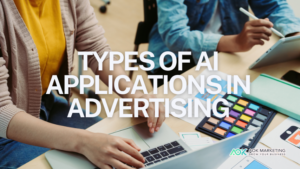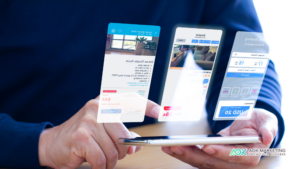Artificial intelligence (AI) has fundamentally transformed the advertising landscape, enabling brands to reach audiences with unparalleled precision, efficiency, and creativity. From predicting consumer behavior to automating ad buying and creating personalized experiences, AI applications are reshaping the industry. Here, we’ll delve into the top types of AI applications in advertising and explore how they enhance campaigns to maximize engagement and ROI.
1. Predictive Analytics: Understanding Consumer Behavior and Forecasting Trends
What is Predictive Analytics?
Predictive analytics uses AI to analyze historical data, identify patterns, and forecast future outcomes. In advertising, it helps brands understand consumer behavior, anticipate market trends, and make data-driven decisions.
Key Benefits in Advertising
Enhanced Targeting: By predicting what consumers are likely to buy or engage with, brands can tailor ads for maximum relevance.
Optimized Campaign Timing: Predictive analytics identifies the best times to launch campaigns, ensuring ads reach audiences when they’re most likely to convert.
Trendspotting: Marketers can stay ahead of the curve by recognizing emerging trends before competitors.
Real-World Example
Netflix uses predictive analytics to recommend shows based on viewer preferences. This approach is mirrored in their advertising, where targeted ads promote specific content to users most likely to watch it.
2. Content Generation: AI Tools for Creating Visuals, Videos, and Ad Copy
What is Content Generation?
AI-powered content generation tools create everything from ad copy to videos and graphics. These tools use machine learning and natural language processing to produce engaging, high-quality content quickly.
Key Benefits in Advertising
Speed and Scalability: AI enables rapid production of content, allowing marketers to scale campaigns effortlessly.
Consistency: AI ensures brand messaging remains cohesive across various platforms.
Creative Assistance: Tools like Jasper and MidJourney offer inspiration and streamline the creative process.
Popular AI Content Tools
Jasper: Generates ad copy and blog posts tailored to specific audience personas.
Canva’s Magic Write: Simplifies graphic design with AI-powered templates and visuals.
Synthesia: Creates AI-generated video ads with human-like avatars.
Real-World Example
Coca-Cola’s 2024 holiday ad, created with generative AI, showcased how AI can blend creativity and efficiency, albeit sparking debates about its emotional resonance.
3. Personalization: Dynamic Ads Tailored to Individual Preferences
What is Personalization?
AI personalization involves tailoring advertisements to individual users based on their preferences, behavior, and demographics. It uses data from various touchpoints to craft highly relevant and engaging campaigns.
Key Benefits in Advertising
Improved Engagement: Personalized ads resonate more deeply with audiences, driving higher click-through and conversion rates.
Customer Loyalty: By addressing individual preferences, brands build stronger connections with their customers.
Reduced Wastage: Resources are focused on crafting ads that are more likely to succeed.
Personalization Strategies
Dynamic Creative Optimization (DCO): AI adjusts ad elements like images, headlines, and call-to-action in real time based on user data.
Geotargeting: Ads are customized based on a user’s location for greater relevance.
Behavioral Targeting: Ads reflect a user’s past interactions, such as browsing or purchase history.
Real-World Example
Amazon excels in personalization by showing product recommendations tailored to individual browsing and purchase habits, resulting in highly effective ad campaigns.
4. Programmatic Advertising: Automated Media Buying for Precise Targeting
What is Programmatic Advertising?
Programmatic advertising automates the buying and selling of ad space using AI, ensuring ads reach the right audience at the right time. It leverages real-time bidding (RTB) to optimize ad placements.
Key Benefits in Advertising
Efficiency: Eliminates manual processes, reducing costs and time.
Precision Targeting: AI ensures ads are displayed to the most relevant audience, improving ROI.
Real-Time Optimization: Campaigns are continuously optimized based on performance data.
How It Works
- Advertisers set campaign goals, budgets, and target audience parameters.
- AI algorithms analyze available ad inventory and bid on impressions in real-time.
- Winning bids place ads in front of the most suitable audience.
Real-World Example
Spotify uses programmatic advertising to deliver tailored audio ads based on user data such as playlists and listening habits, creating a seamless user experience.
5. Customer Engagement: Chatbots, Virtual Assistants, and Conversational AI
What is Customer Engagement with AI?
AI-powered chatbots and virtual assistants enable brands to engage with customers in real time, providing personalized assistance and creating interactive experiences.
Key Benefits in Advertising
24/7 Availability: Chatbots can handle queries and provide support anytime, enhancing customer satisfaction.
Lead Generation: Conversational AI collects valuable user data, helping brands refine their targeting and messaging.
Cost Savings: Automating customer interactions reduces the need for large support teams.
Popular Applications
Chatbots: Used for customer service, product recommendations, and lead nurturing.
Voice Assistants: Alexa, Siri, and Google Assistant integrate with advertising strategies, offering voice-activated brand interactions.
Conversational Ads: Ads designed as interactive experiences where users can ask questions or explore products.
Real-World Example
H&M’s chatbot on Kik helps users find outfits based on their preferences, offering a highly engaging and personalized shopping experience.
Integrating AI Applications: The Future of Advertising
Combining Applications for Maximum Impact
The true power of AI in advertising lies in its ability to integrate multiple applications seamlessly. For instance:
-Predictive analytics can identify audience segments.
-Content generation tools create tailored visuals and copy.
-Programmatic advertising ensures these ads reach the right audience.
-Personalization enhances the user experience by delivering highly relevant ads.
-Conversational AI maintains engagement, answering queries and driving conversions.
Emerging Trends
Voice-Activated Ads: Leveraging AI to create campaigns optimized for voice search and smart speakers.
Augmented Reality (AR): AI-powered AR ads allow users to interact with products virtually, enhancing engagement.
Ethical AI Practices: Transparency and responsible use of consumer data will be critical in gaining trust and ensuring compliance.
Conclusion
AI applications have revolutionized advertising by offering tools that enhance efficiency, creativity, and customer engagement. Predictive analytics helps brands anticipate trends, while content generation tools streamline creative production. Personalization ensures campaigns resonate with individual users, and programmatic advertising maximizes ROI through precision targeting. Finally, AI-driven customer engagement tools keep audiences connected and satisfied.
As AI continues to evolve, its applications in advertising will only become more sophisticated. By integrating these tools strategically, brands can stay ahead in an ever-competitive market and build meaningful connections with their audiences.
The future of advertising is here, and it’s powered by AI. Are you ready to harness its potential?
About The Author
Marketing Team
The AOK Marketing Team is a diverse group of amazing individuals driven to help all of our clients succeed. Great people are everywhere, and we believe that people should control their workday, their work environment, and where they live. We have team members in 9 countries: United States, Canada, Egypt, Belgium, Ireland, Australia, India, Pakistan, and Hong Kong.
How can we help you?







